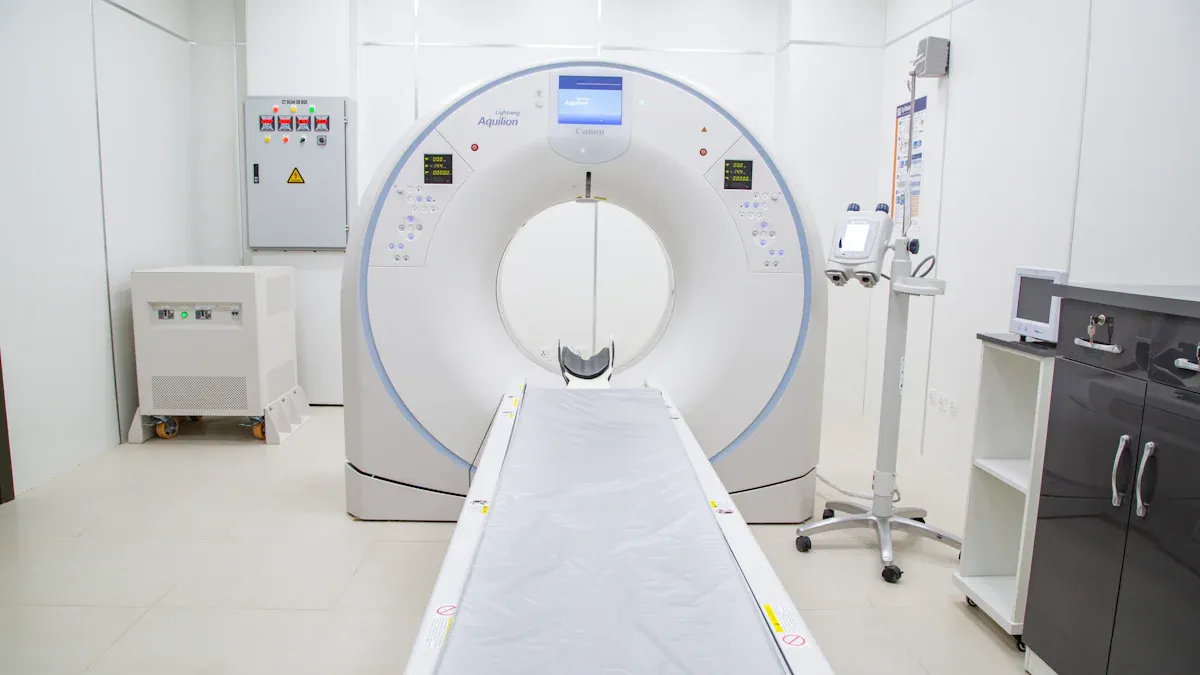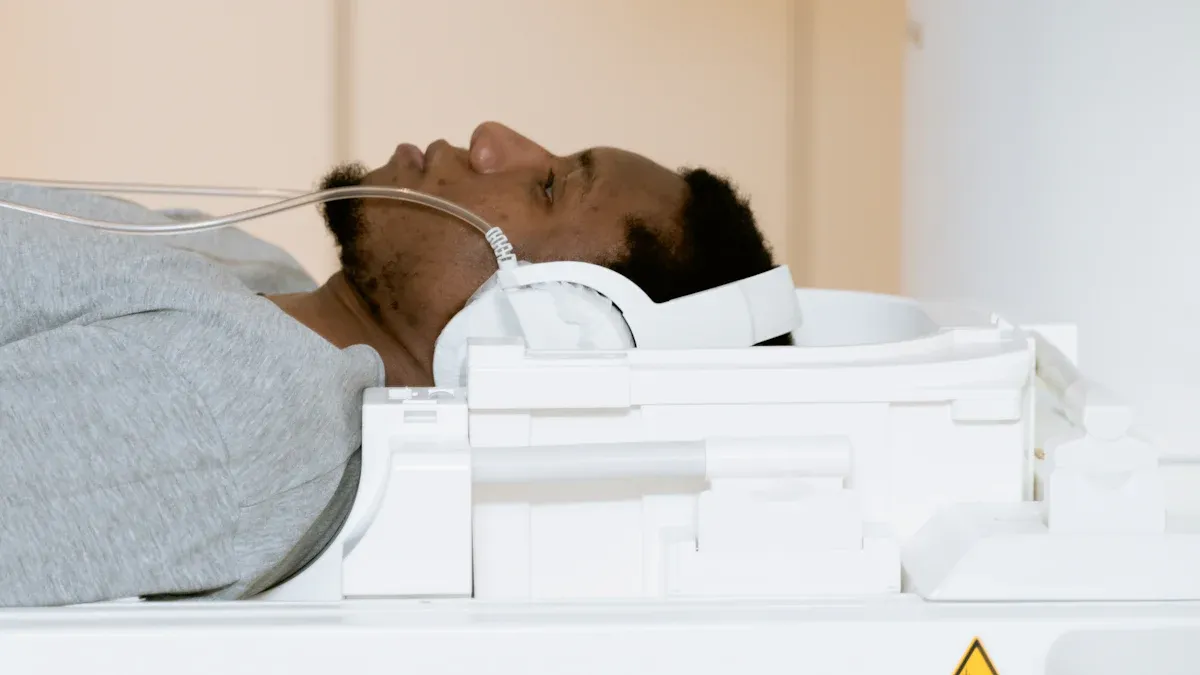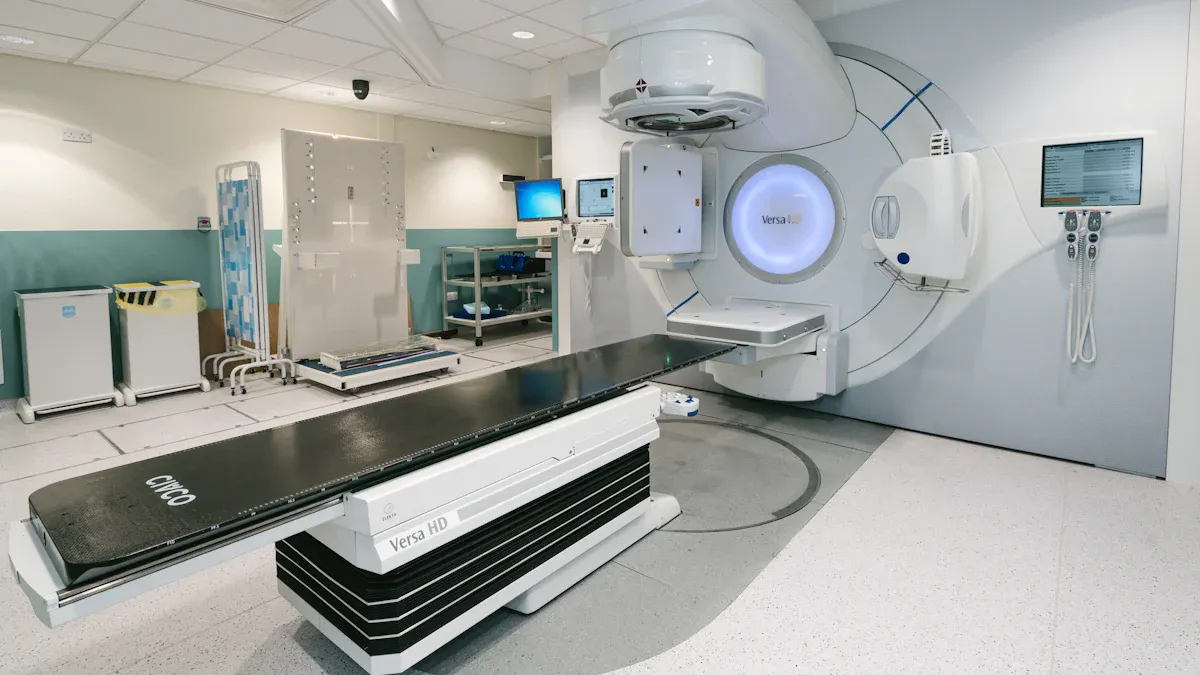Why Nitinol Neurovascular Coils Are Game-Changing

Nitinol stands out as a revolutionary material in neurovascular treatments. Its unique properties, such as superelasticity and shape memory, allow precise placement of the coil within the intricate structure of wide-neck intracranial aneurysms. You can trust nitinol neurovascular coils for aneurysm treatment to adapt seamlessly to complex vascular geometries. Their biocompatibility also ensures long-term safety, reducing the risk of complications. These coils have transformed the treatment of wide-neck aneurysms, offering a safer and more effective solution for patients. By using nitinol, medical professionals achieve remarkable outcomes in aneurysm care.
Key Takeaways
Nitinol neurovascular coils are very flexible and easy to use. They work well for treating tough wide-neck aneurysms.
Nitinol has special traits like bending easily and keeping its shape. This helps place the coil correctly and keeps it steady during surgery.
Nitinol is safe for the body, lowering risks and helping it work well for a long time.
Studies show nitinol coils block blood flow well, leading to better results and fewer repeat surgeries.
Using nitinol neurovascular coils improves aneurysm care with smart technology and better patient health.
What Makes Nitinol Unique?

Superelasticity in Neurovascular Applications
Nitinol's superelasticity is one of its most remarkable features, making it ideal for neurovascular applications. This property allows the material to undergo significant deformation and return to its original shape without permanent damage. For example, nitinol can bend and stretch to navigate the intricate pathways of the brain's blood vessels. Once deployed, it resumes its intended form, ensuring precise placement and stability.
This superelastic behavior stems from a unique transformation between two solid phases: austenite and martensite. Unlike traditional materials, nitinol can endure extreme mechanical stress. Studies show that thin-film nitinol can stretch up to 500% radially and bend up to 180° without losing its structural integrity. These capabilities make it invaluable for treating conditions like wide-neck aneurysms, where flexibility and precision are critical.
Shape Memory for Complex Vascular Geometries
The shape memory effect is another standout feature of nitinol. This property enables the material to "remember" its original shape and return to it when exposed to specific conditions, such as heat. This ability is particularly useful in neurovascular procedures, where devices must adapt to complex and variable anatomical structures.
For instance, nitinol neurovascular coils can be compressed for insertion into a catheter and then expand to their pre-set shape once deployed in the blood vessel. This adaptability ensures that the coil conforms perfectly to the aneurysm's geometry, improving treatment outcomes. Research highlights that shape memory alloys like nitinol enhance the navigation and placement of devices in challenging vascular networks. This capability is crucial for accessing hard-to-reach areas and ensuring effective treatment.
Nitinol's shape memory effect was first demonstrated in 1961, showcasing its transformative potential compared to other materials. Its ability to transition between phases and adapt to microstructural changes sets it apart, making it a game-changer in medical applications.
Biocompatibility and Long-Term Safety
When it comes to medical devices, biocompatibility and safety are non-negotiable. Nitinol excels in both areas, making it a trusted material for neurovascular applications. Its biocompatibility ensures that it interacts harmoniously with the body's tissues, reducing the risk of adverse reactions.
Long-term studies have confirmed nitinol's excellent safety profile. For example, nitinol implants comply with FDA and international standards, ensuring reliability and patient safety. Additionally, adherence to ISO 10993 standards evaluates factors like cytotoxicity and irritation, further validating its biocompatibility. Clinical evidence over a decade shows that nitinol implants maintain their performance and compatibility with the human body.
Moreover, nitinol's biomechanical compatibility enhances its effectiveness. It works seamlessly with the surrounding tissues, minimizing complications and improving patient outcomes. This combination of biocompatibility and durability makes nitinol a superior choice for neurovascular treatments.
How Nitinol Enhances Aneurysm Treatment
Precise Deployment in Wide-Neck Aneurysms
Nitinol neurovascular coils for aneurysm treatment excel in precise deployment, especially in wide-neck intracranial aneurysms. These coils adapt to the aneurysm's geometry, ensuring accurate placement and stability. You can rely on nitinol's superelasticity and shape memory to achieve optimal coil placement, even in complex cases.
Stent-assisted coiling has become a preferred method for treating wide-neck aneurysms. Stents act as scaffolds, preventing coil dislocation and ensuring proper deployment. Numerical simulations of patient-specific endovascular stenting demonstrate how high-porosity neuro-stents reduce coil herniation. This approach enhances the safety and effectiveness of the coiling procedure.
Evidence Description | Key Findings |
|---|---|
Stent-assisted coiling of broad-necked intracranial aneurysms | Stents prevent coil dislocation, enabling precise deployment. |
Numerical simulation of patient-specific endovascular stenting | High-porosity neuro-stents reduce coil herniation in wide-necked aneurysms. |
Precise deployment minimizes the risk of complications and improves the overall success rate of the treatment. With nitinol neurovascular coils, you can trust that the treatment of wide-neck aneurysms will deliver superior outcomes.
Adaptability to Challenging Anatomical Positions
The adaptability of nitinol neurovascular coils makes them invaluable for treating wide-neck intracranial aneurysms in challenging anatomical positions. These coils conform to the unique structure of each aneurysm, ensuring effective treatment even in hard-to-reach areas.
Imaging studies confirm the flexibility of nitinol-based devices like the Neuroform stent. This stent allows for successful coil occlusion in wide-neck aneurysms without causing device-related adverse events. In one case study, a Neuroform stent enabled the deployment of coils, achieving 95% occlusion. The patient was discharged asymptomatic, highlighting the effectiveness of nitinol in complex cases.
Evidence Description | Outcome |
|---|---|
Flexibility of the Neuroform stent allows for successful coil occlusion in wide-necked aneurysms. | No device-related adverse events; procedure-related complications occurred in seven patients without severe deficits. |
In 16 out of 18 patients, the Neuroform device enabled stent-assisted coil occlusion. | Occlusion rates were 95% in eight patients and 100% in another eight. |
A case study demonstrated the deployment of a Neuroform stent and successful coil occlusion of an aneurysm. | The patient was discharged asymptomatic with 95% occlusion achieved. |
This adaptability ensures that nitinol neurovascular coils for aneurysm treatment can address even the most complex cases. You can count on these coils to navigate intricate vascular pathways and deliver effective results.
Reduced Risk of Complications During and After Treatment
Safety is a top priority in the treatment of wide-neck aneurysms. Nitinol neurovascular coils reduce the risk of complications during and after the coiling procedure. Their biocompatibility minimizes adverse reactions, while their mechanical properties ensure stability and durability.
The precise deployment and adaptability of nitinol coils also contribute to their safety profile. By conforming to the aneurysm's geometry, these coils reduce the likelihood of coil migration or herniation. This stability is crucial for preventing complications such as re-rupture or incomplete occlusion.
Clinical studies have shown that nitinol-based devices achieve high occlusion rates with minimal complications. For example, the Neuroform stent demonstrated a 95% occlusion rate in eight patients and a 100% rate in another eight. These results highlight the reliability and effectiveness of nitinol in the treatment of wide-neck intracranial aneurysms.
When you choose nitinol neurovascular coils for aneurysm treatment, you prioritize both effectiveness and safety. These coils set a new standard in neurovascular care, offering a safer and more reliable solution for patients.
Comparison with Other Materials
Limitations of Stainless Steel and Platinum
When comparing materials for aneurysm treatment, stainless steel and platinum have notable limitations. Stainless steel lacks the high flexibility required to navigate the intricate pathways of neurovascular structures. Its rigidity can make it challenging to achieve precise coil placement, especially in wide-neck aneurysms. Platinum, while more flexible than stainless steel, falls short in terms of adaptability. It cannot conform as effectively to complex vascular geometries, which can compromise the success of coiling procedures.
Both materials also face challenges in long-term safety and performance. Stainless steel may corrode over time, potentially leading to complications. Platinum, though biocompatible, does not offer the same durability as nitinol. These limitations highlight the need for a material that combines flexibility, adaptability, and long-term reliability.
Advantages of Nitinol in Flexibility and Performance
Nitinol stands out as a superior choice due to its unique properties. Its high flexibility allows it to navigate the brain's intricate vascular pathways with ease. This flexibility ensures precise coil placement, even in challenging anatomical positions. You can trust nitinol to adapt seamlessly to the aneurysm's geometry, enhancing the effectiveness of the coiling procedure.
In terms of performance, nitinol excels in both safety and performance. Its superelasticity and shape memory enable it to maintain stability within the aneurysm, reducing the risk of complications. Unlike stainless steel or platinum, nitinol offers a combination of flexibility, durability, and biocompatibility that ensures long-term success.
Superior Outcomes with Nitinol Neurovascular Coils
Nitinol neurovascular coils consistently deliver superior outcomes in aneurysm treatment. Their ability to conform to complex vascular structures ensures effective occlusion of the aneurysm. Clinical studies have shown that nitinol-based devices achieve higher occlusion rates with fewer complications compared to those made from stainless steel or platinum.
For example, nitinol coils used in stent-assisted coiling procedures have demonstrated remarkable success in treating wide-neck aneurysms. Patients experience improved safety and performance, with reduced risks of coil migration or incomplete occlusion. These outcomes make nitinol the material of choice for neurovascular applications, setting a new standard in aneurysm care.
Real-World Impact of Nitinol Neurovascular Coils

Case Studies in the Treatment of Wide-Neck Aneurysms
Nitinol neurovascular coils for aneurysm treatment have demonstrated remarkable success in real-world cases. Studies highlight their effectiveness in achieving high occlusion rates, even in challenging scenarios like wide-neck intracranial aneurysms.
A review of 17 studies revealed that 46.3% of patients (278 out of 601) achieved immediate complete occlusion after coiling.
When near-complete obliteration (95-99% occlusion) was included, the success rate increased to 76.2% (474 out of 622).
Follow-up angiography conducted in 74% of treated aneurysms showed that 71.9% (310 out of 431) achieved complete occlusion over a mean follow-up period of 5.6 to 43.2 months.
These results underscore the reliability of nitinol coils in the treatment of wide-neck aneurysms. Their ability to conform to complex vascular geometries ensures effective and lasting outcomes.
Clinical Evidence Supporting Nitinol's Effectiveness
Clinical studies consistently validate the superior performance of nitinol neurovascular coils. Their unique properties, such as superelasticity and shape memory, enable precise deployment and stability within wide-neck intracranial aneurysms. This leads to improved safety and reduced risks of complications.
For example, stent-assisted coiling procedures using nitinol-based devices have achieved high occlusion rates with minimal adverse events. Patients treated with these coils experience better long-term outcomes compared to those treated with traditional materials. The combination of flexibility, durability, and biocompatibility makes nitinol the preferred choice for neurovascular applications.
Testimonials from Medical Professionals and Patients
Medical professionals frequently praise nitinol neurovascular coils for their transformative impact on aneurysm treatment. Neurosurgeons often highlight their adaptability and precision, which simplify procedures and improve patient outcomes. One surgeon noted, "Nitinol coils have revolutionized how we approach wide-neck aneurysms. Their performance and safety are unmatched."
Patients also share positive experiences. Many report quick recoveries and long-term relief after undergoing coiling procedures with nitinol devices. One patient stated, "I felt reassured knowing my treatment involved the best technology available. The results have been life-changing."
These testimonials reflect the real-world benefits of nitinol neurovascular coils. They not only enhance the effectiveness of aneurysm treatment but also improve the quality of life for patients.
Nitinol neurovascular coils have redefined aneurysm treatment by combining superelasticity, shape memory, and biocompatibility. These properties ensure precise coil placement, adaptability to complex vascular structures, and long-term safety. Clinical data highlights their success, with a 95.5% implantation rate and occlusion rates exceeding 87% over two years. Reintervention is rare, occurring in only 5.6% of cases. You can trust nitinol coils to deliver unmatched performance and safety, setting a new standard in neurovascular care. Their transformative impact continues to improve outcomes for patients with wide-neck aneurysms.
FAQ
What makes nitinol better than other materials for neurovascular coils?
Nitinol offers unmatched flexibility, superelasticity, and shape memory. These properties allow it to adapt to complex vascular structures and maintain stability. Unlike stainless steel or platinum, nitinol ensures precise placement and long-term safety, making it the superior choice for aneurysm treatment.
Are nitinol neurovascular coils safe for long-term use?
Yes, nitinol is biocompatible and meets FDA and ISO standards. It interacts well with body tissues and minimizes adverse reactions. Clinical studies confirm its durability and safety over time, ensuring reliable performance in neurovascular applications.
Can nitinol coils treat all types of aneurysms?
Nitinol coils are especially effective for wide-neck aneurysms and challenging anatomical positions. Their adaptability and precision make them suitable for most cases. However, your doctor will determine the best treatment based on your specific condition.
How do nitinol coils reduce complications during treatment?
Nitinol's superelasticity and shape memory ensure precise deployment and stability. These properties minimize risks like coil migration or incomplete occlusion. Its biocompatibility also reduces the likelihood of adverse reactions, ensuring a safer treatment process.
What do patients say about nitinol neurovascular coils?
Patients often report positive outcomes and quick recoveries. Many feel reassured knowing their treatment involves advanced technology. One patient shared, "The results have been life-changing, and I’m grateful for the care I received."
See Also
Nitinol Tubing's Impact on the Future of Healthcare Devices
Nitinol Tubing's Contribution to Modern Medical Innovations
Nitinol Tubing: Shaping the Future of Medical Equipment
The Importance of Nitinol Tubing in Medical Advancements
Nitinol Tubing: Key to Successful Minimally Invasive Techniques

